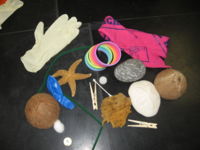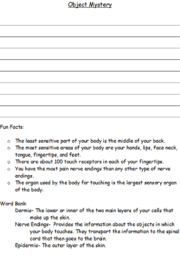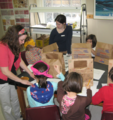Object Mystery
| Instant wiki maker | Making handouts | Editing tips |
Contents
- 1 Student worthiness
- 2 Primary biological content area covered
- 3 Materials
- 4 Handouts
- 5 Description of activity
- 6 Lesson plan
- 7 Potential pitfalls
- 8 English connections
- 9 Art connections
- 10 Literature connections
- 11 Connections to educational standards
- 12 Next steps
- 13 Reflections
- 14 Citations and links
Biology In Elementary Schools is a Saint Michael's College student project from a course that ran between 2007 and 2010 and fully described in this book chapter. The student-created resources have been preserved here for posterity. Link under 'toolbox' for printer-friendly versions of the exercises. Click on handouts to print full resolution versions. Please see Wikieducator's disclaimer, our safety statement, and the Creative Commons licensing in English and in legalese.
Student worthiness
Tested and Worked
Primary biological content area covered
- Observation
- Human senses, touch
Materials
- Blind folds
- Brown paper bags
- Stapler
- Pencils
- Large note cards or pieces of white paper cut in half
- Various objects, such as: cotton balls, bobby pins, sandpaper, cloth, feathers, dried glue, rocks, buttons, pipe cleaners, coconut shells, plastic flowers, plastic beads, clothes pins, sponge, piece of tree bark, sea glass, fur, paperclips, koosh ball, Styrofoam, Play Dough, balloons, plastic ball, Starfish, Q-tips, rubber gloves, rubber bands, and sea shells.
- Category chart (soft, rough, smooth, rubber)
Handouts
A handout with fun facts and a word bank will be provided to the students. The students will also be provided with a skin diagram to label. The students may use the word bank from the first handout.
Description of activity
This experiment allows students to explore their sense of touch! Our sense of touch is found all over our body. It originates at the very bottom layer of our skin known as the dermis. It is the dermis that contains tiny nerve endings which provides us with information about the objects our body comes into contact with. The nerve endings transport the information to the spinal cord which then sends messages to the brain. Our bodies have about twenty types of nerve endings, the most common receptors are heat, cold, pressure, pain, and touch receptors.
Through this fun activity, students have the chance to use their sense of touch and develop a better understanding of how they are affected by the objects around them. Based on an individual's sense of touch, they can categorize objects and observe how others interpret specific objects. This activity allows the students to acknowledge how our hands are important to our sense of touch and they can learn to appreciate the use of our hands.
[1]
[2]
Lesson plan
1. First, ask the group of students how sense of touch is a part of their daily routine. This way the students will gain an understanding of how our hands are used in daily activities.
Questions to consider:
- What did you touch when you were getting ready for school this morning?
- What did you eat for breakfast? Was it hot or cold?
- How did your sense of touch play a role in the way you prepared for the day ahead?
2. Pass out the handout and the diagram that correlates with the word bank. Have the students take turns reading the fun facts.
-Do any of these fun facts surprise you?
3. At the bottom of the handout, there are three terms: dermis, nerve endings, and epidermis. The students can read the definitions then fill out the diagram.
4. Provide each student with a half piece of white paper. They will divide this piece of paper into a grid of four squares. Have the students label each box with the four categories that will be in their object mystery bags.
The following are the categories for the grid:
- Smooth
- Rough
- Soft
- Rubber
5. Each student will receive a brown paper bag that has four objects in it. They should not look
inside their bag. Blindfold each student and have them reach inside the bag, holding one object at
a time. It is important to keep in mind that some students might not like to be blindfolded.
6. Allow the children to feel their first object and develop their own hypothesis as to what they
believe the object is based on their sense of touch. The students hypotheses will vary but the main idea is that the use of touch is vital to distinguish most objects. They will record their first object in the square they believe it should go. Have the students draw the object or they may write what they believe the object is in the box. For example, if they felt a starfish, they may draw it in the box that is labeled rough or they can write starfish.
7. The students should repeat step 6 for each object.
8. After the children draw and label their four boxes for each of their objects, tell them to grab their handout that they were given at the beginning of the lesson.
9. Students can reflect on their feelings as they reached their hand into the bag. They may also write about how they interpreted the four objects based only on their sense of touch.
- What made them decide to place an object in a certain category?
- Based on their sense of touch, what characteristics of the object did they focus on that helped them make a decision?
- Do they notice on the grid any objects that could be placed in other categories?
- Do the students understand the importance of touch?
- Photographs of the experiment in progress
Potential pitfalls
The students might already know what is in the bags before they guess or they might be able to see through the blindfolds.
English connections
After the activity the students will write and reflect about the experience they had. They are able to reflect on how they felt as they reached into the bag, how they determined what the objects were, and their reactions to the experiment.
Art connections
The students will draw what they feel in the paper bag on large note cards or half of a sheet of paper. They will divide their piece of paper into a grid of four squares labeled rough, smooth, rubber, and soft. They will draw an object in each labeled square based on their sense of touch. You can focus on specific details that the students added to their pictures based on their sense of touch.
- How did they show that an object was rough? Did they make the object appear to be jagged or bumpy?
- If the object was smooth, what characteristics are portrayed?
Later the students can go back and color the pictures and place them around the room.
Literature connections
Silverstein, S. 1974. Where the Sidewalk Ends Harper Collins Publisher.
In Shel Silverstein's Where the Sidewalk Ends there is a poem titled What's In The Sack?(page 111)this fun poem asks the reader to identify what may be in a sack. It implies that with our sense of touch we may investigate and figure out what the objects are. This poem is a great resource to tie in with this science experiment! After reading the poem to the class, have the students do the experiment and discuss their findings.
Cole, J. and B. Degen. 1999. The Magic School Bus Explores the Senses Scholastic Inc.
The Magic School Bus series by Joanna Cole and Bruce Degen are very popular for young students. In this particular book, The Magic School Bus Explores the Senses, students can learn more about the five human senses and how they are used. For this Object Mystery experiment, students can relate to Ms. Frizzle's class' experience inside the body and their observations inside the brain that is receiving touch messages from the hand. "Once we were standing on it, we could somehow feel what Ms. Frizzle felt! When she felt something hot or cold, or hard or soft, we did too!" This picture book is full of information and is very intriguing for young scientists. They are able to explore all of the senses in a fun way!
Connections to educational standards
Scientific Method
- 7.1 Students use scientific methods to describe, investigate, explain phenomena and raise questions in order to:
- generate alternative explanations-hypotheses- based on observations and prior knowledge
A. Ask questions about objects, organisms, and events in the world around them
Matter, Motion, Forces, and Energy
- 7.12 Students understand forces and motion, the properties and composition of matter, and energy sources and transformations. This is evident when students:
A. Sort objects and materials according to observations of similarities and differences of properties (e.g. size, weight, color, shape, temperature. [3]
Next steps
To further investigate the sense of touch, you can repeat the activity (filling the bags with new and different objects) and see how the inability to use one or more fingers could affect the students' sense of touch. You can also experiment with the students using only one hand at a time to see if they have the same results. Putting new and different objects in the bags will provide the students with other opportunities to explore the sense of touch.
Reflections
Overall, I think that our activity, object mystery, went really well. We did not anticipate having more than six students per group so a couple students had to share a bag but it worked out in the end! I think that the fourth graders really enjoyed reaching into the bag and trying to figure out what the objects were without seeing them. One girl wanted to repeat the process again with another bag that one of her classmates had! I think that introducing the terms that correlate with the sense of touch first was helpful for them. We went over fun facts and had a word bank so that the students would be familiar with the specific terms and how our sense of touch works. It was a fun experience and I am glad that the students enjoyed themselves!
-Megan
I think that our experiment, Object Mystery, went very well and was very successful. The only problem, I believe, was that we were not prepared to have more than six students per group and sometimes there were as many as eight students in a group. Unfortunately, we only had enough materials to make one extra bag. At times, therefore, students had to share a bag. We did, however, have an abundance of blindfolds. Overall, I think that the students enjoyed the “mystery” and some even seemed eager to try the activity a second time with another bag. As we expected, some students did not want to be blindfolded, but these students were still honest and did not look in the bag. The group- work was also successful. My partners and I split up the group-work and the teaching time. Each group member took charge of two out of the six groups.
-Casey
I think that the experiment went well and I enjoyed working with the students. However, we did not have enough bags for each of the students because we were not expecting more than six students per group, but one group member went and made another bag. After making the extra bag we still did not have enough bags for the students, so some of the students had to share. The students worked well together when they had to share. It was great to see the interaction of the students with one another and also the three of us interacting with the students too. We all took turns teaching the groups and each of our teaching styles were different and I learned different ways to address the students too. It was fun experience and I enjoyed working with the students.
-Monica
Citations and links
http://library.thinkquest.org/3750/touch/touch.html
http://library.thinkquest.org/28457/touch.shtml
http://www.education.vermont.gov/new/html/pubs/framework.html





